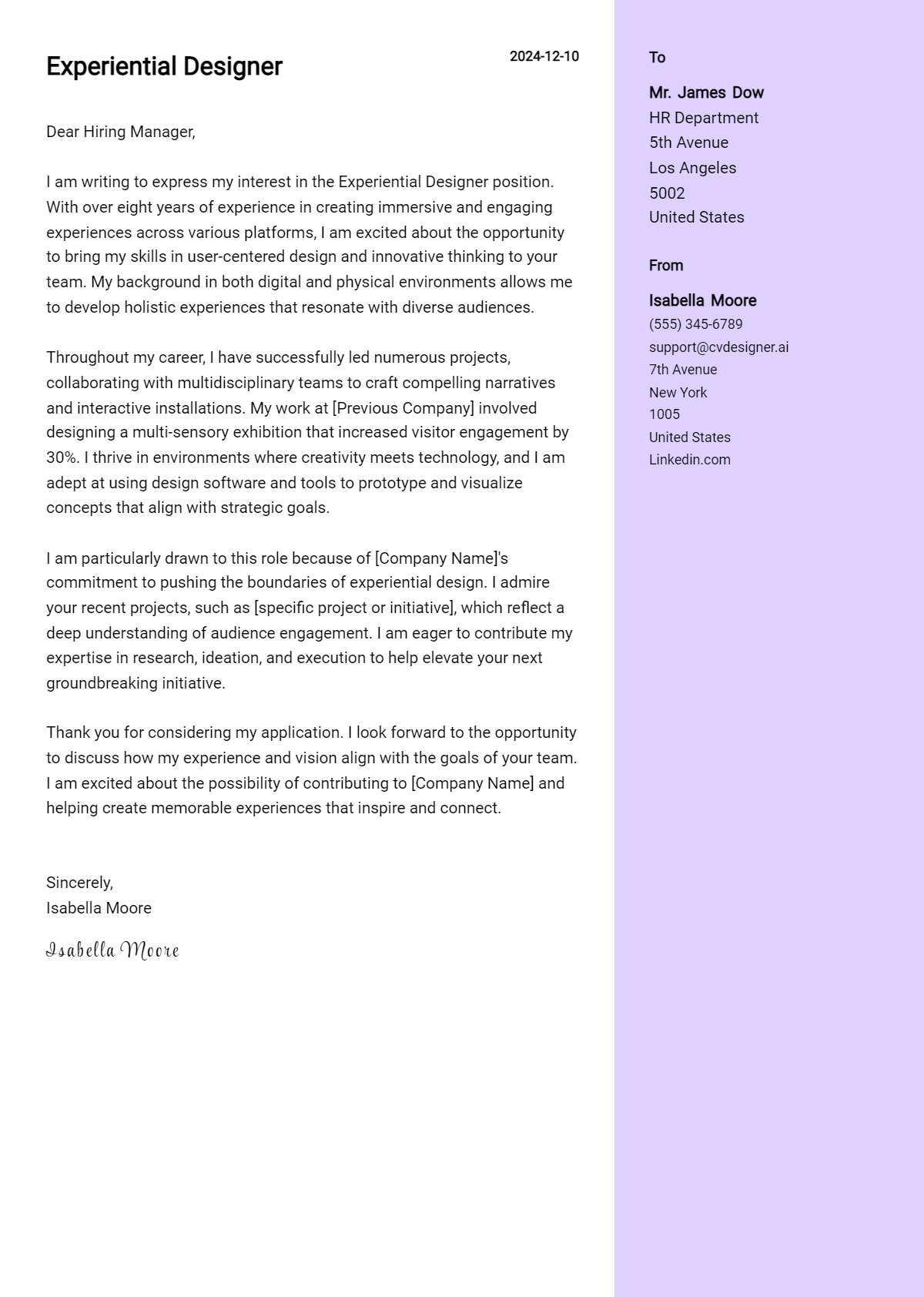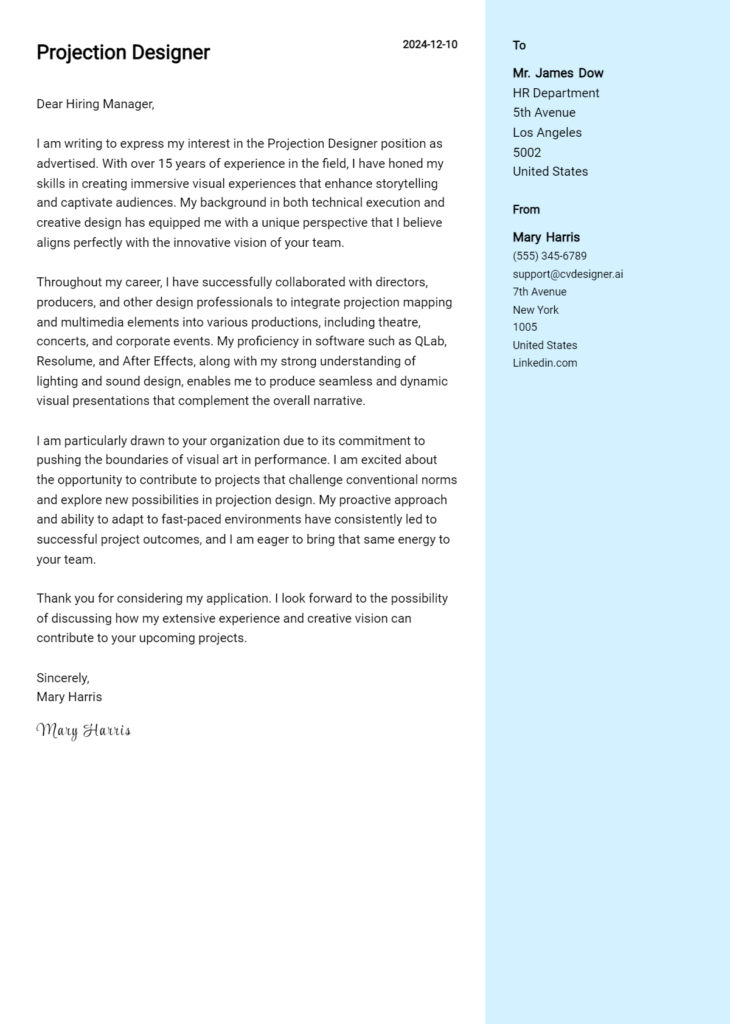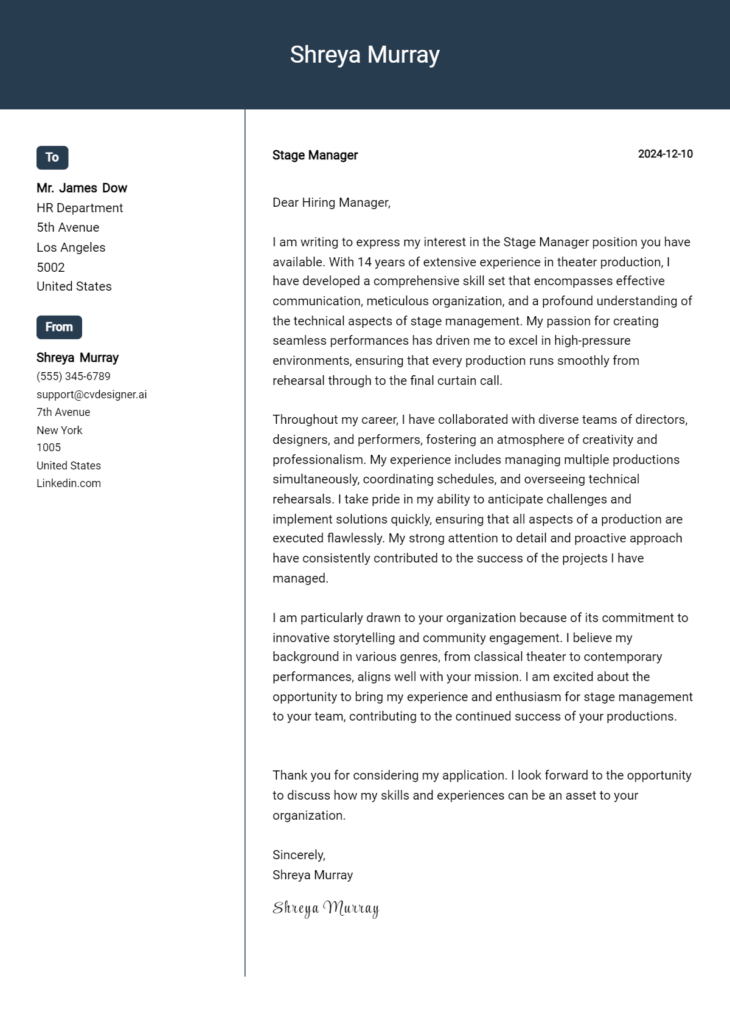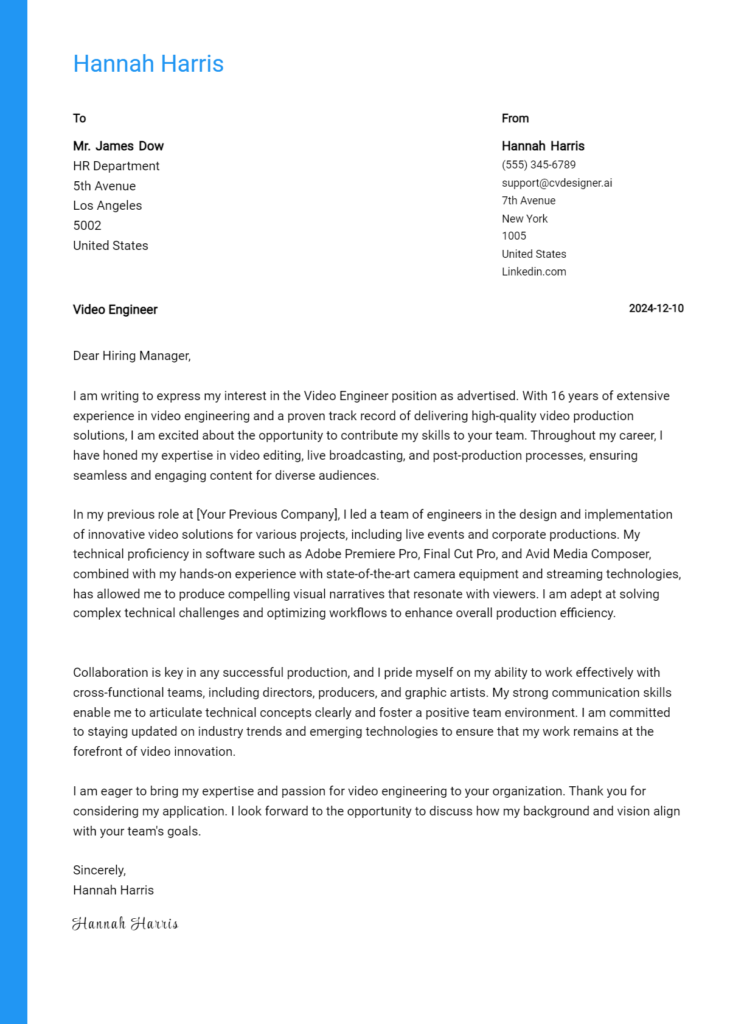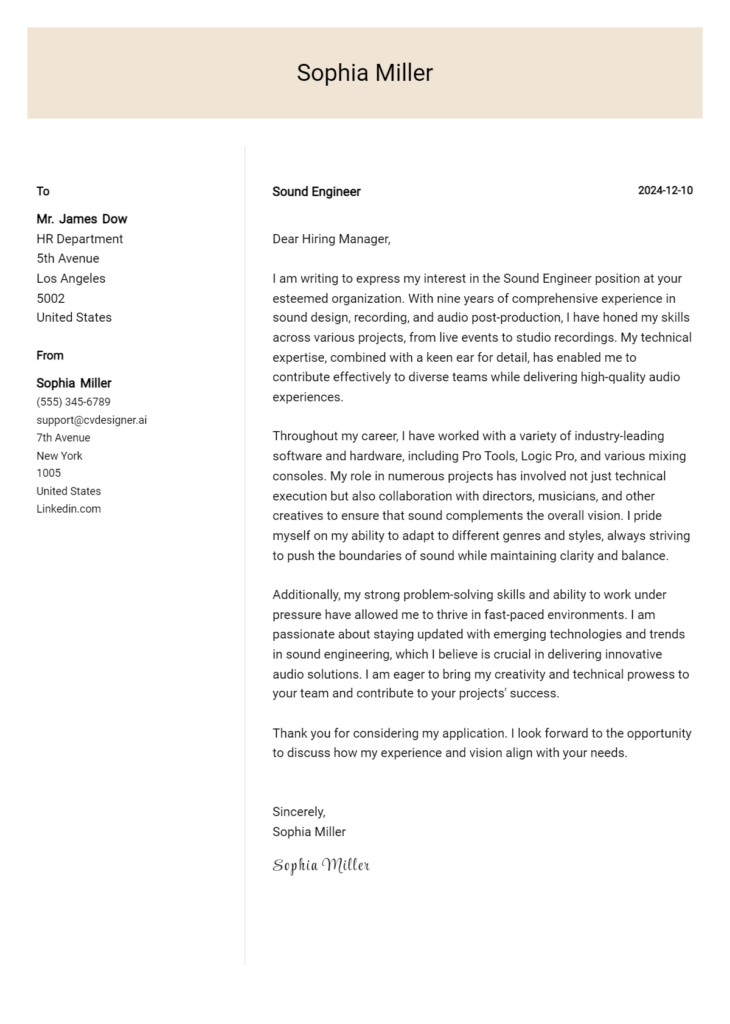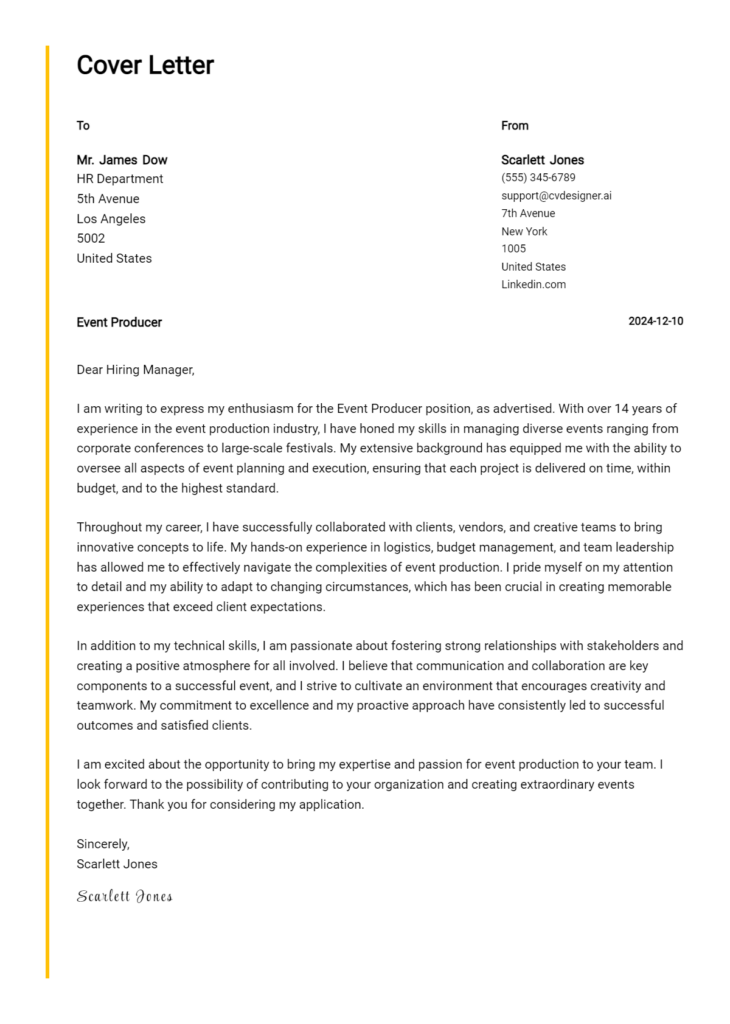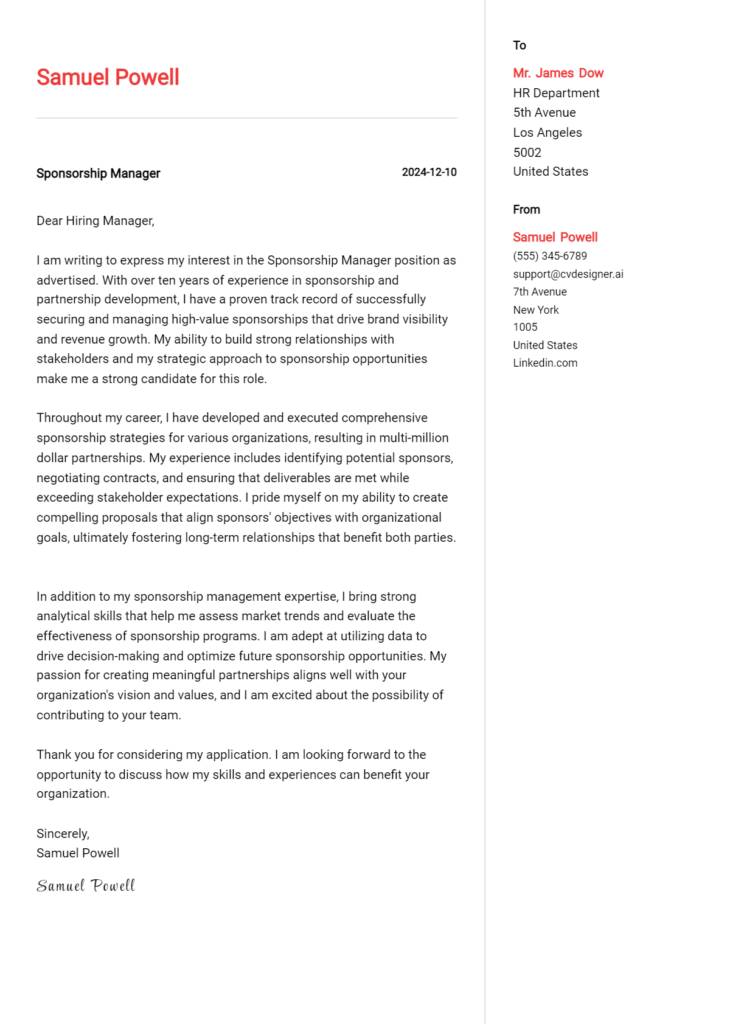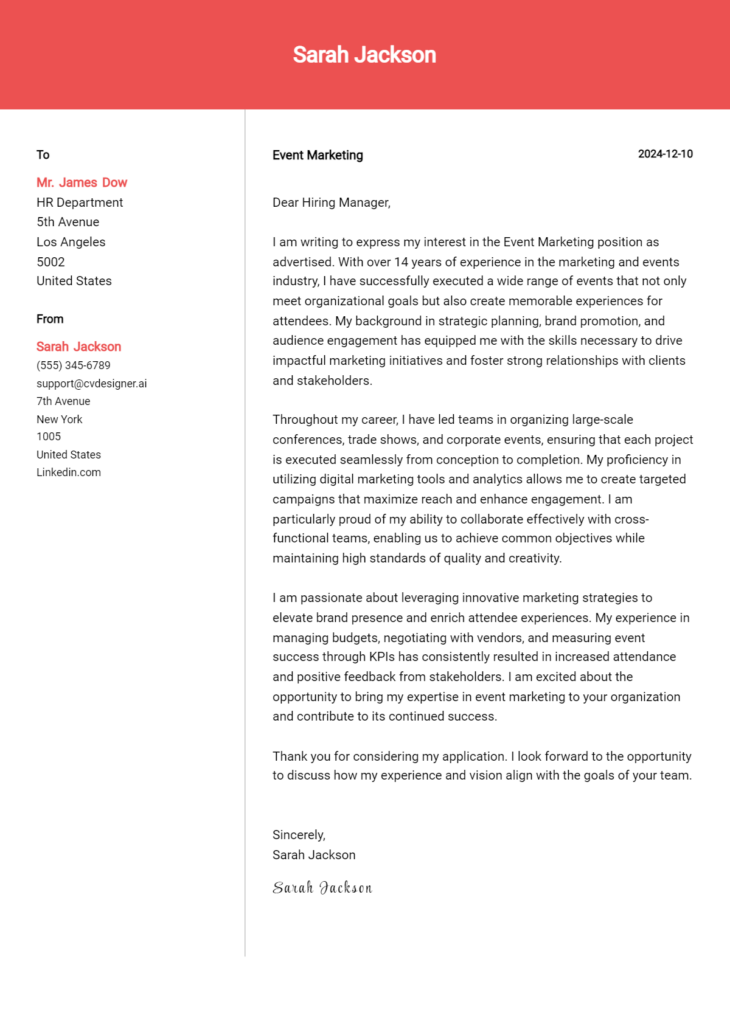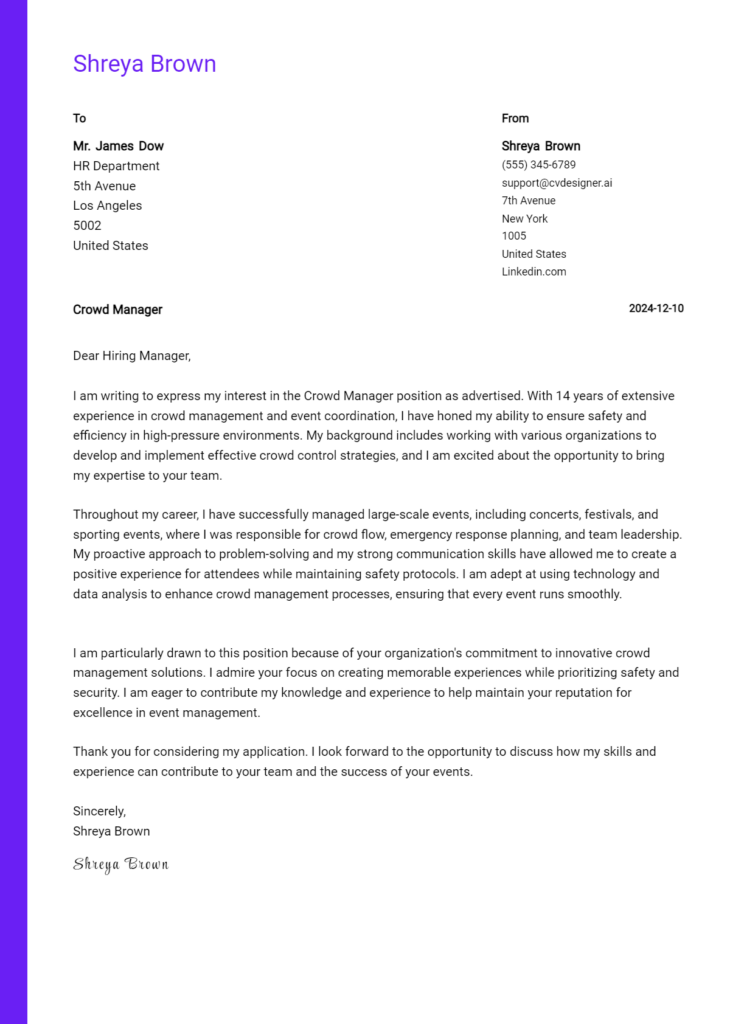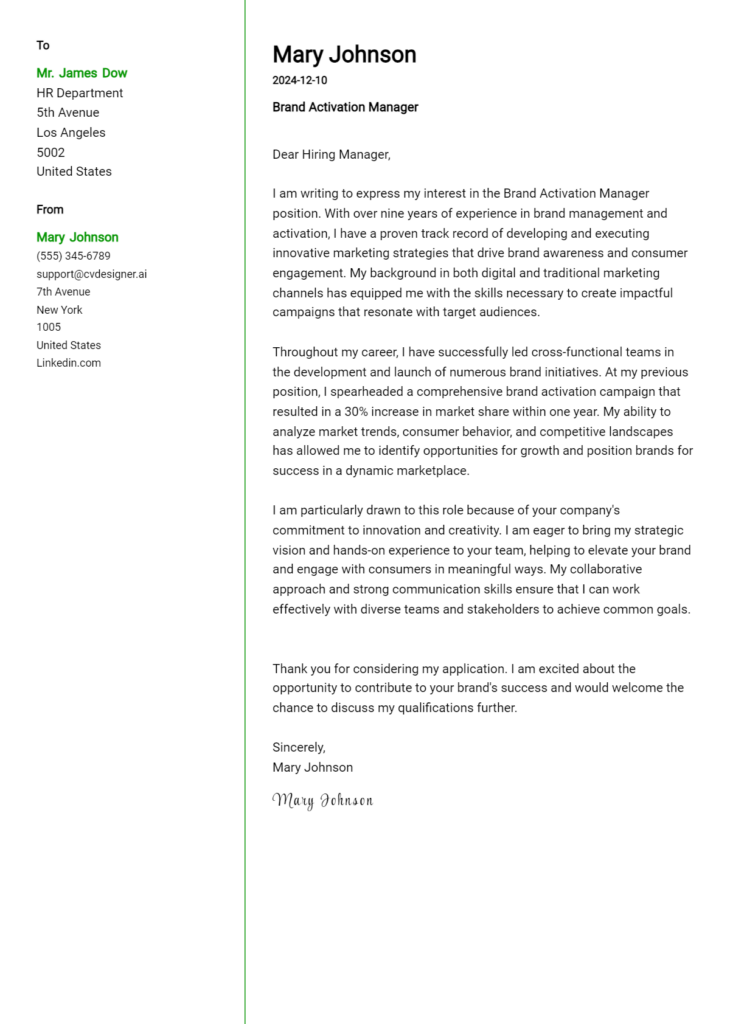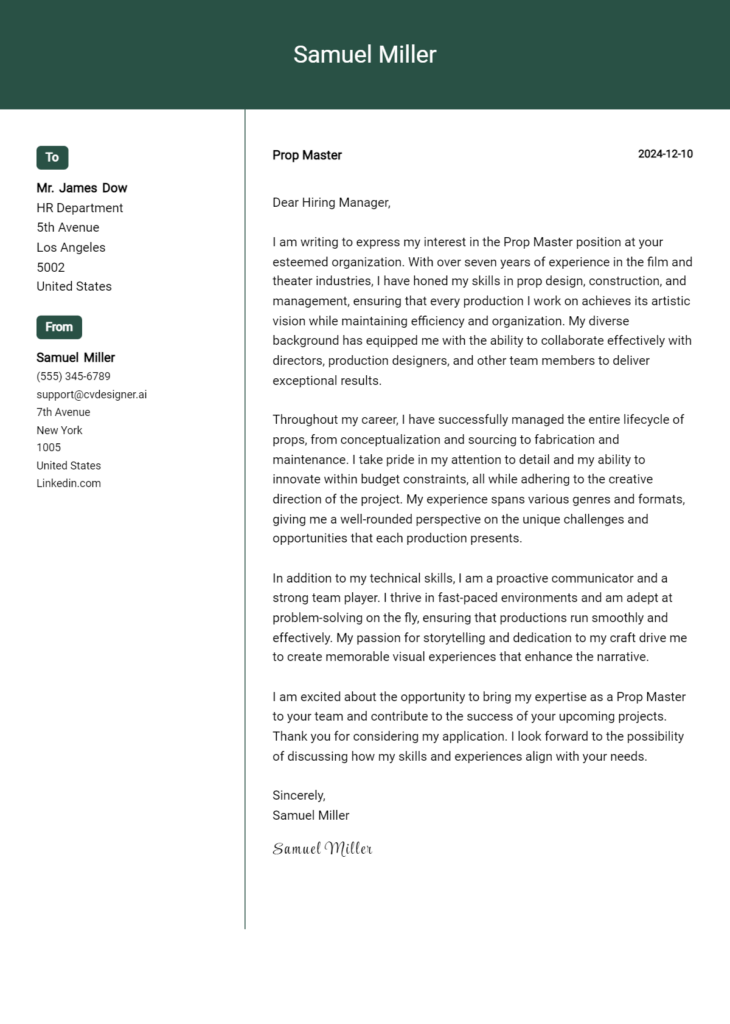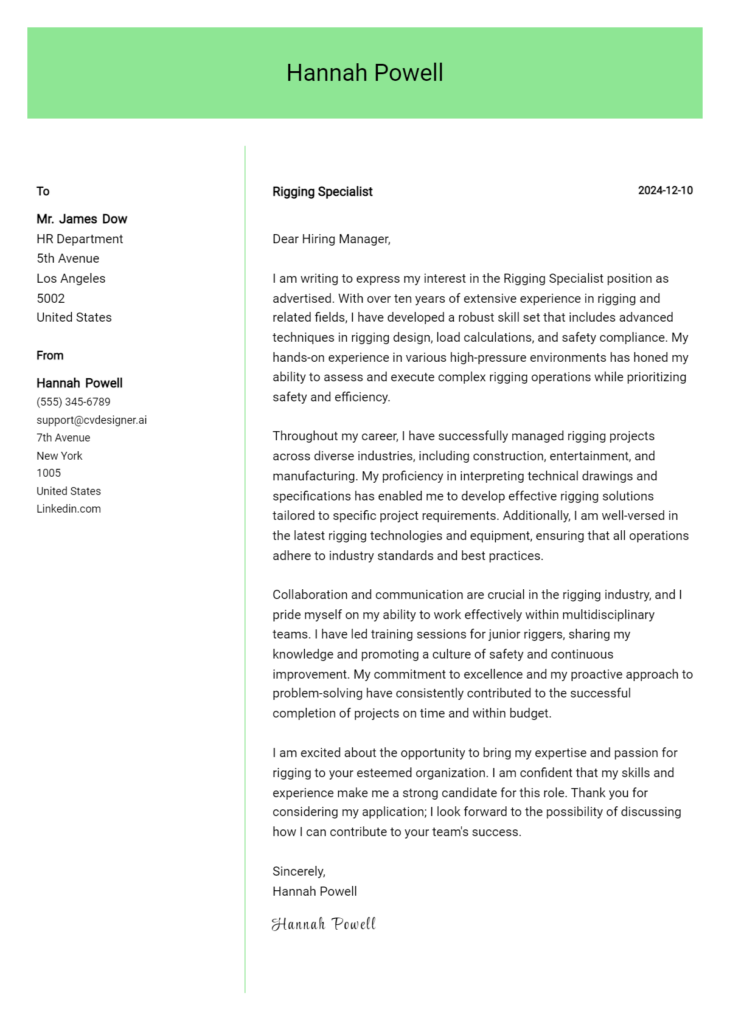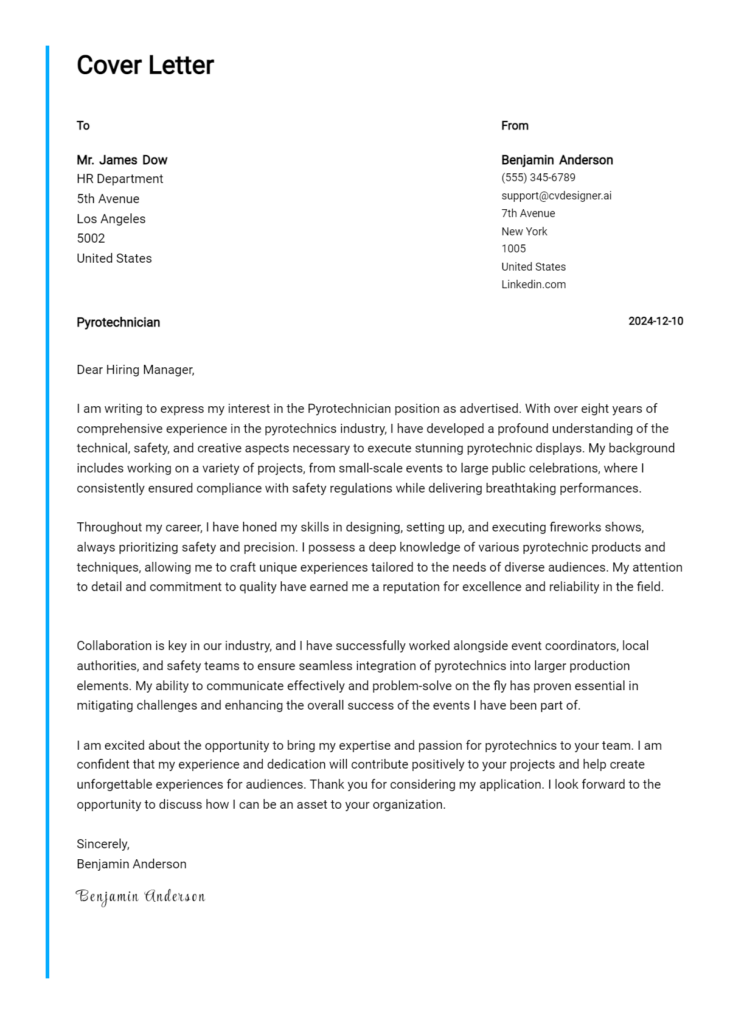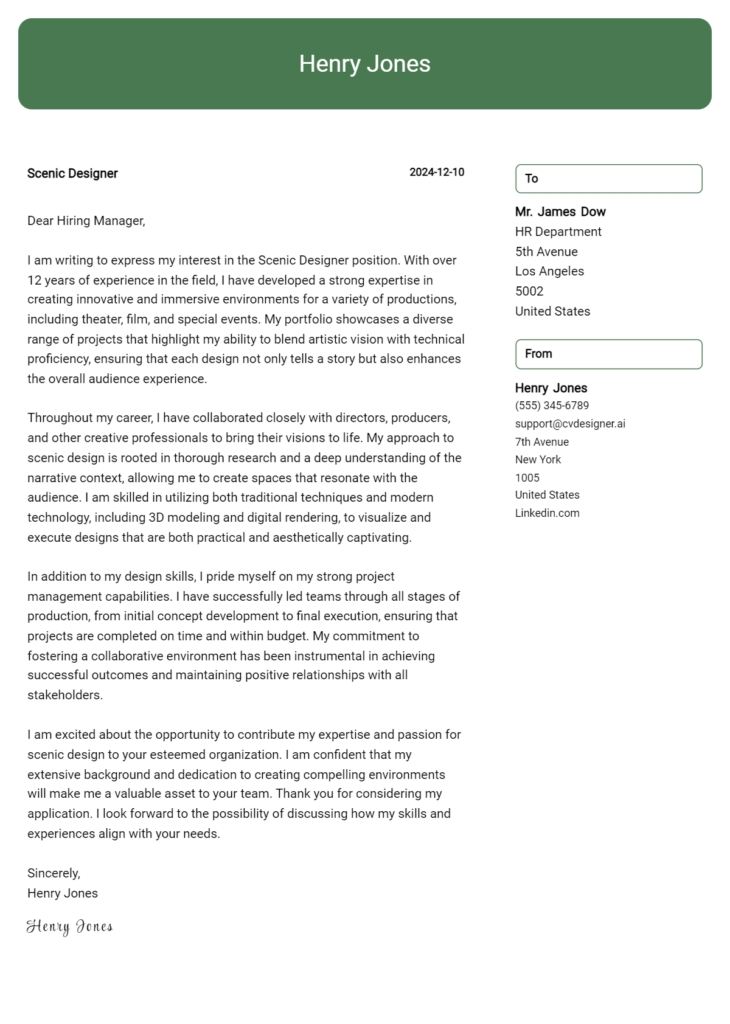Experiential Designer Cover Letter Examples
Explore additional Experiential Designer cover letter samples and guides and see what works for your level of experience or role.
How to Format an Experiential Designer Cover Letter?
Crafting an engaging cover letter is essential for an Experiential Designer, as it serves as a canvas to showcase your creativity and innovative thinking. The format of your cover letter not only highlights your design skills but also reflects your ability to communicate ideas effectively, which is crucial in experiential design. A well-structured cover letter can capture the attention of hiring managers by demonstrating your understanding of the user experience, your attention to detail, and your passion for creating memorable interactions.
In this guide, we'll discuss how to structure your cover letter, providing insights and experiential design-specific examples to help you create a compelling document.
We'll focus on the essential components of a professional cover letter, including:
- Cover Letter Header
- Cover Letter Greeting
- Cover Letter Introduction
- Cover Letter Body
- Cover Letter Closing
Each section plays a vital role in highlighting your qualifications and creativity. Let’s break down each part and explain how to make your experiential designer cover letter stand out.
Importance of the Cover Letter Header for an Experiential Designer
A well-crafted cover letter header is essential for making a strong first impression as an Experiential Designer. This section sets the tone for your application and conveys professionalism and attention to detail—qualities that are vital in the design industry. The header should include your contact information, the date, and the recipient's details, ensuring clarity and ease of communication. A clear and organized header not only reflects your design sensibility but also allows hiring managers to quickly access your information.
Below are examples of a strong and weak cover letter header for an Experiential Designer:
Strong Example
Jane Doe 123 Design Ave Creative City, CA 90210 (123) 456-7890 jane.doe@email.com October 10, 2023 Hiring Manager Innovative Experiences Inc. 456 Creativity Lane Design Town, CA 90211
Weak Example
From: Jane Email: jane@email.com Date: 10/10/23 To Whom It May Concern
The Importance of a Cover Letter Greeting for an Experiential Designer
The greeting of your cover letter is more than just a formality; it sets the tone for the entire document and serves as your first impression on the hiring manager. A well-crafted greeting demonstrates professionalism and shows that you have taken the time to personalize your application. By addressing the hiring manager directly, you create a connection that can draw them into your narrative. It’s important to avoid generic greetings like "To Whom It May Concern," as they can make your application seem impersonal and unenthusiastic. Take the time to research the recipient's name or even their title if necessary, as this small effort can speak volumes about your dedication and attention to detail.
Strong Greeting Example
Dear Ms. Johnson,
Weak Greeting Example
To Whom It May Concern,
The Importance of a Well-Crafted Cover Letter Introduction for an Experiential Designer
A compelling cover letter introduction is crucial for an Experiential Designer as it sets the tone for the entire application and serves as the first impression to the hiring manager. This initial paragraph should not only capture attention but also convey genuine interest in the role while highlighting relevant skills or noteworthy achievements. A strong introduction can entice the reader to continue, while a weak one may lead to dismissal. Below are examples that illustrate both effective and ineffective approaches to crafting a captivating cover letter introduction.
Strong Example
Dear [Hiring Manager's Name], As a passionate Experiential Designer with over five years of experience in creating immersive brand experiences, I was thrilled to discover the opportunity at [Company Name]. My recent project, which garnered a Silver Award at the XYZ Design Awards, not only showcased my ability to blend innovative design with cutting-edge technology but also reinforced my commitment to delivering unforgettable user experiences. I am excited to bring my unique perspective and creative vision to your team, helping to elevate [Company Name]'s experiential initiatives to new heights.
Weak Example
Hello, I saw the job posting for the Experiential Designer position. I have some experience in design and think I could do a good job. I have worked on a few projects and can use programs like Photoshop. I hope to hear back from you soon.
Purpose of the Cover Letter Body for an Experiential Designer
The body of a cover letter for an Experiential Designer serves as a critical platform to showcase the candidate's unique skills, experiences, and the value they can bring to the company. It is an opportunity to illustrate a deep understanding of the role, highlighting specific projects or accomplishments that demonstrate creativity, problem-solving abilities, and successful collaboration with teams. By detailing relevant experiences, candidates can effectively convey how their background aligns with the company’s goals and how they can enhance the customer experience through innovative designs and engaging environments.
Strong Example
Dear Hiring Manager, As an experienced Experiential Designer, I am excited about the opportunity to contribute to your team at XYZ Company. In my previous role at ABC Agency, I successfully led a project for a major tech brand’s product launch that increased foot traffic by 40% and enhanced customer engagement through immersive installations. By integrating interactive elements and leveraging storytelling, we created a memorable experience that not only showcased the product but also resonated with the target audience. My ability to collaborate with cross-functional teams and adapt designs based on real-time feedback has consistently resulted in projects that exceed client expectations. I am eager to bring this skill set and my passion for innovative design to XYZ Company. Sincerely, [Your Name]
Weak Example
Dear Hiring Manager, I am writing to apply for the Experiential Designer position at your company. I have worked in design for a few years and have done some projects. I think I would be a good fit because I like creating experiences. In my last job, I worked on some designs and tried to make them engaging. I hope to bring my skills to your team. Best, [Your Name]
Importance of the Cover Letter Closing for an Experiential Designer
The closing of a cover letter is crucial for an Experiential Designer as it serves as the final opportunity to leave a lasting impression on the hiring manager. A strong closing summarizes key qualifications and reiterates enthusiasm for the position, while also encouraging the reader to take the next steps, such as reviewing the resume or scheduling an interview. A well-crafted closing can effectively reinforce your suitability for the role and express your eagerness to contribute to the company’s vision.
Strong Example
Thank you for considering my application for the Experiential Designer position. With my background in creating engaging, user-centered experiences and my passion for innovative design, I am excited about the opportunity to contribute to your team. I believe my skills in interactive installations and immersive storytelling align perfectly with your company’s mission. I look forward to the possibility of discussing my application further and am eager to share how my experiences can benefit your projects. Please feel free to contact me to schedule an interview at your convenience. Thank you once again for your time and consideration.
Weak Example
I hope you look at my resume. I'm interested in the Experiential Designer job. Let me know if you want to talk more. Thanks.
These tips will assist candidates in crafting an effective cover letter for the Experiential Designer role. A well-written cover letter is crucial for showcasing your technical skills, problem-solving abilities, knowledge of the Software Development Life Cycle (SDLC), teamwork, and a passion for continuous learning. By emphasizing these qualities, you can create a compelling narrative that captures the attention of potential employers.
Tips for Crafting an Effective Cover Letter for Experiential Designers
Highlight Technical Skills: Clearly outline your technical proficiencies relevant to experiential design, such as proficiency in design software (like Adobe Creative Suite or Sketch), knowledge of coding languages (like HTML, CSS, or JavaScript), and any experience with interactive media. Use specific examples to demonstrate these skills in action, making it easier for employers to visualize your contributions.
Showcase Problem-Solving Abilities: Share instances where you successfully tackled design challenges or improved user experiences. Detail your thought process and the methods you employed to arrive at a solution. This demonstrates your analytical skills and your ability to provide tangible results, which are crucial in the experiential design field.
Demonstrate SDLC Knowledge: Mention your familiarity with the Software Development Life Cycle. Briefly describe how your understanding of each phase—from planning and design to development and deployment—has informed your design process. This illustrates your holistic approach and ability to collaborate effectively with developers and stakeholders.
Emphasize Teamwork: Provide examples of how you have worked successfully within a team environment. Highlight your ability to collaborate with cross-functional teams, communicate ideas clearly, and contribute to a collective vision. Mention any leadership roles or initiatives where you helped foster a positive team dynamic.
Communicate a Passion for Continuous Learning: The design field is ever-evolving, so expressing your commitment to professional development is essential. Mention any workshops, courses, or certifications you’ve pursued, as well as your willingness to adapt to new technologies and trends. This will convey your enthusiasm and proactive nature to potential employers.
For more resources, consider exploring cover letter templates and utilizing a cover letter builder to streamline your writing process.
Common Mistakes to Avoid in a Experiential Designer Cover Letter
Crafting a cover letter for an Experiential Designer position is a critical step in making a strong first impression. Avoiding common mistakes can significantly enhance your chances of standing out to potential employers. Here are some pitfalls to steer clear of:
- Generic Content: Using a one-size-fits-all approach can make your cover letter feel impersonal. Tailor your letter to the specific company and role.
- Neglecting Design: As an Experiential Designer, your design sensibility should shine through. Ensure your cover letter is visually appealing and aligns with your portfolio.
- Lack of Specificity: Failing to highlight specific projects or experiences can weaken your application. Use concrete examples to illustrate your skills.
- Ignoring the Job Description: Not addressing the key qualifications mentioned in the job posting can make your application seem unfocused. Align your skills with their requirements.
- Poor Formatting: A cluttered or unprofessional format can distract from your content. Follow proper cover letter format guidelines to ensure clarity and professionalism.
- Overly Lengthy: Being too verbose can lose the reader's interest. Aim for concise and impactful statements.
- Typos and Errors: Grammatical mistakes can undermine your credibility. Always proofread and consider having someone else review your letter.
By avoiding these common mistakes and focusing on a tailored, well-designed cover letter, you can enhance your chances of securing that coveted interview. For more guidance, check out these cover letter examples.
Cover Letter FAQs for Experiential Designer
What should I include in my cover letter as an Experiential Designer?
Your cover letter should highlight your relevant experience, skills, and passion for experiential design. Begin with a strong opening that captures attention and introduces your specialization. Include specific examples of past projects that showcase your ability to create immersive experiences, such as exhibitions, events, or installations. Emphasize your knowledge of user experience principles and your proficiency in design software. Don’t forget to mention any collaboration with multidisciplinary teams, as this is crucial in experiential design. Lastly, convey your enthusiasm for the potential employer's brand and how you can contribute to their vision through innovative design solutions.
How can I tailor my cover letter for a specific job?
To tailor your cover letter for a specific job, start by thoroughly researching the company and its projects. Identify key values or themes in their work that resonate with you. Customize your introduction to reflect your enthusiasm for their brand and mission. In the body, align your skills and experiences with the job description, using specific terminology they employ. Highlight relevant projects and outcomes that reflect similar goals. Finally, conclude with a personalized statement that reiterates your fit for the role and your eagerness to contribute to their team, making it clear that you've invested time understanding their needs.
How long should my cover letter be?
A cover letter for an Experiential Designer position should ideally be one page, consisting of three to four concise paragraphs. Aim for a word count between 250 to 400 words, ensuring you communicate your message effectively without overwhelming the reader. Focus on quality over quantity; every sentence should add value to your application. Use the introduction to capture attention, the body to detail your relevant experience and skills, and the conclusion to express enthusiasm and a call to action for an interview. Keeping it succinct allows hiring managers to engage with your key points quickly.
Should I include a portfolio link in my cover letter?
Yes, absolutely! Including a link to your portfolio is highly recommended for an Experiential Designer cover letter. Your portfolio serves as a visual testament to your skills and creativity, allowing potential employers to see your work firsthand. When mentioning your portfolio, provide a brief description of what they can expect to find, such as specific projects that relate to the job you're applying for. Ensure the link is easily accessible and functioning. A well-curated portfolio can significantly enhance your application, giving you a competitive edge by demonstrating your ability to translate ideas into compelling experiences.
Build your Cover Letter in minutes
Use an AI-powered cover letter builder and have your letter done in 5 minutes. Just select your template and our software will guide you through the process.

